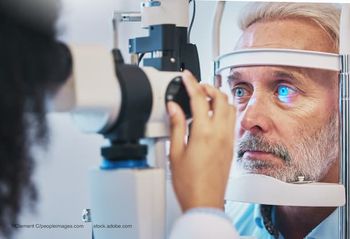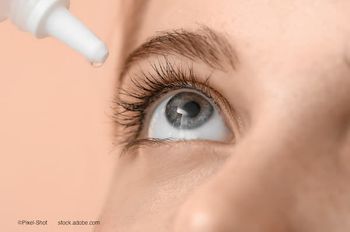
Froin syndrome: Eyes are the window to the spine
Papilledema with back pain suggests spine lesion.
Special to Ophthalmology Times®
Froin syndrome is described in the medical literature as the combination of xanthochromia, elevated protein, and hypercoagulated cerebrospinal fluid (CSF).
Discussion
Froin syndrome is characterized by xanthochromia and hypercoagulability of the cerebrospinal fluid (CSF).1
The etiology of the condition stems from either meningeal irritation or blockage of the spinal canal by a mass, leading to reduction of CSF flow.
Papilledema is a consequence of high CSF protein that interrupts the CSF reabsorption process occurring at the level of the arachnoid granulations.
The CSF protein levels can increase to at least 5 g/L, as compared to the normal values of 0.15 to 0.45 g/L.2
Schully et al suggested that the spinal subarachnoid space below a spinal block behaves like a cul-de-sac.3
Consequently, there is diminished pressure in the cul-de-sac, as connection with the spinal fluid above the compression has been cut.
In addition, pial veins are dilated at the site of compression, resulting in transudation. The aforementioned stasis and transudative nature of the fluid results in hypercoagulability.4
The workup for a patient who has symptoms consistent with Froin syndrome usually starts with brain and spine imaging.5
An MRI typically shows the spine lesion causing the CSF outflow obstruction or elevated CSF protein.
A representative case presentation
A 35-year-old obese woman develops severe lower back pain and blurred vision. An ophthalmologist finds 20/30 vision in both eyes (OU) with Frisen grade 3 papilledema and severe visual field constriction OU.
MRI of the brain and orbit with MR venography (MRV) were negative.
A lumbar puncture yielded no CSF and a “dry tap” MRI of the spine showed a thoracic ependymoma.
After neurosurgical resection a spinal tap showed an opening pressure of 30 cm of water and an elevated CSF protein of 100 mg/dL consistent with Froin syndrome.
Summary
Clinicians should be aware that papilledema with back pain is suggestive of a spine lesion.
A normal brain MRI with MRV produces a false sense of security for clinicians.
A dry tap (from obstruction) or an elevated CSF protein are the main findings in spine lesions producing papilledema in Froin syndrome.
Treatment of the primary lesion in the spine may not result in complete resolution immediately because of persistent postoperative CSF inflammatory pleocytosis or elevated CSF protein.
Junsang Cho, BA, University of Missouri School of Medicine, Columbia, Missouri; Anika Tanwani, BS, University of Texas Medical Branch, Galveston, Texas; Sami Younes, BS, School of Medicine, Baylor College of Medicine, Houston, Texas; and Chao Charoenkijkajorn, MD, Department of Ophthalmology, Blanton Eye Institute, Houston Methodist Hospital, Texas, all contributed to this report.
Andrew G. Lee, MD
Lee, editor of The Neuro-Connection column, is affiliated with the Blanton Eye Institute, Houston Methodist Hospital. He did not indicate proprietary interest.
--
References
- Govindarajan R, Khan T. Froin’s syndrome: an uncommon mimicker of Guillain-Barre syndrome. Eur Spine J. 2012;21(8):1674-1675. doi:10.1007/s00586-012-2277-0
- Greenfield JG. Original Papers: ON FROIN’S SYNDROME, AND ITS RELATION TO ALLIED CONDITIONS IN THE CEREBROSPINAL FLUID. J Neurol Psychopathol. 1921;2(6):105-141. doi:10.1136/jnnp.s1-2.6.105
- Scully FJ. Yellow spinal fluid—its origin and significance. Arch Neur Psych 1923 Jul;10(1):83-99.
- Garispe A, Naji H, Dong F, Arabian S, Neeki M. Froin’s syndrome secondary to traumatic and infectious etiology. Cureus. 2019;11(12):e6313. doi:10.7759/cureus.6313
- Mirza S, Adams WM, Corkhill RA. Froin’s syndrome revisited, 100 years on. Pseudo-Froin’s syndrome on MRI. Clin Radiol. 2008;63(5):600-604. doi:10.1016/j.crad.2007.07.027
Newsletter
Don’t miss out—get Ophthalmology Times updates on the latest clinical advancements and expert interviews, straight to your inbox.


















































.png)


